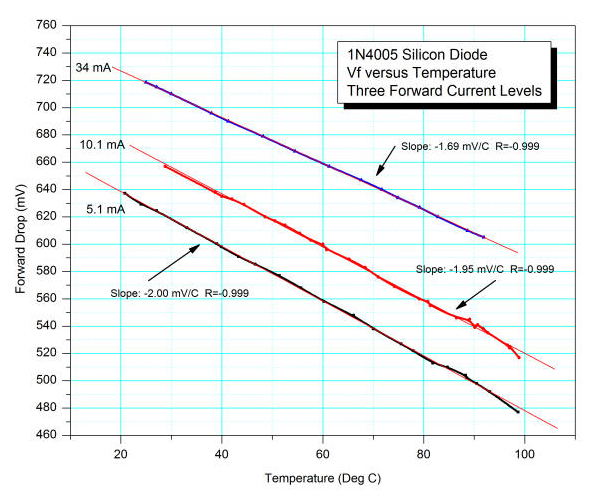Disclaimer
This information HAS errors and is made available WITHOUT ANY WARRANTY OF ANY KIND and without even the implied warranty of MERCHANTABILITY or FITNESS FOR A PARTICULAR PURPOSE. It is not permissible to be read by anyone who has ever met a lawyer or attorney. Use is confined to Engineers with more than 370 course hours of engineering.
If you see an error contact:
+1(785) 841 3089
inform@xtronics.com
Temperature Compensation
Rules of thumb - diode
- Diodes forward drop goes down as temperature goes up
- For a given current, the V/I curve shifts down by approximately 2 mV/°C.
-

- where:
- I = the net current flowing through the diode.
- Is
= "dark saturation current", or is the reverse bias saturation current
(or scale current) the diode leakage current density in the absence of
light. Is approximately doubles for every 10 °C increase in temperature - this temperature effect dominates the one in the exponent and results in the voltage drop with temperature. Is is related to the area of the junction and just how it was made.
- V = applied voltage across the terminals of the diode.
- q = absolute value of electron charge.
- k = Boltzmann's constant.
- T = absolute temperature (K).
- n = ideality factor, a number between 1 and 2 which typically increases as the current decreases.
- It is possible to pull the thermal voltage VT out of the
equation - VT is approximately 25.85 mV at 300 K, a temperature close to
"room temperature" commonly used in device simulation software. This
voltage you will see in
Zero_Gain_Amps.
-


- But β increases with increasing temperature
Simplified trans-conductance of a Transistor
-

or
-

Transistor current ratios
- Doubling the collector current will cause an increase of about 18mv in Vbe or:
-

- Where ,
 at room temperature
at room temperature
Email





 at room temperature
at room temperature